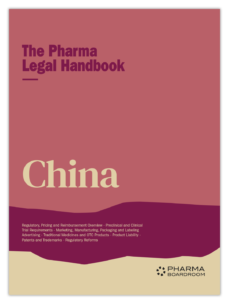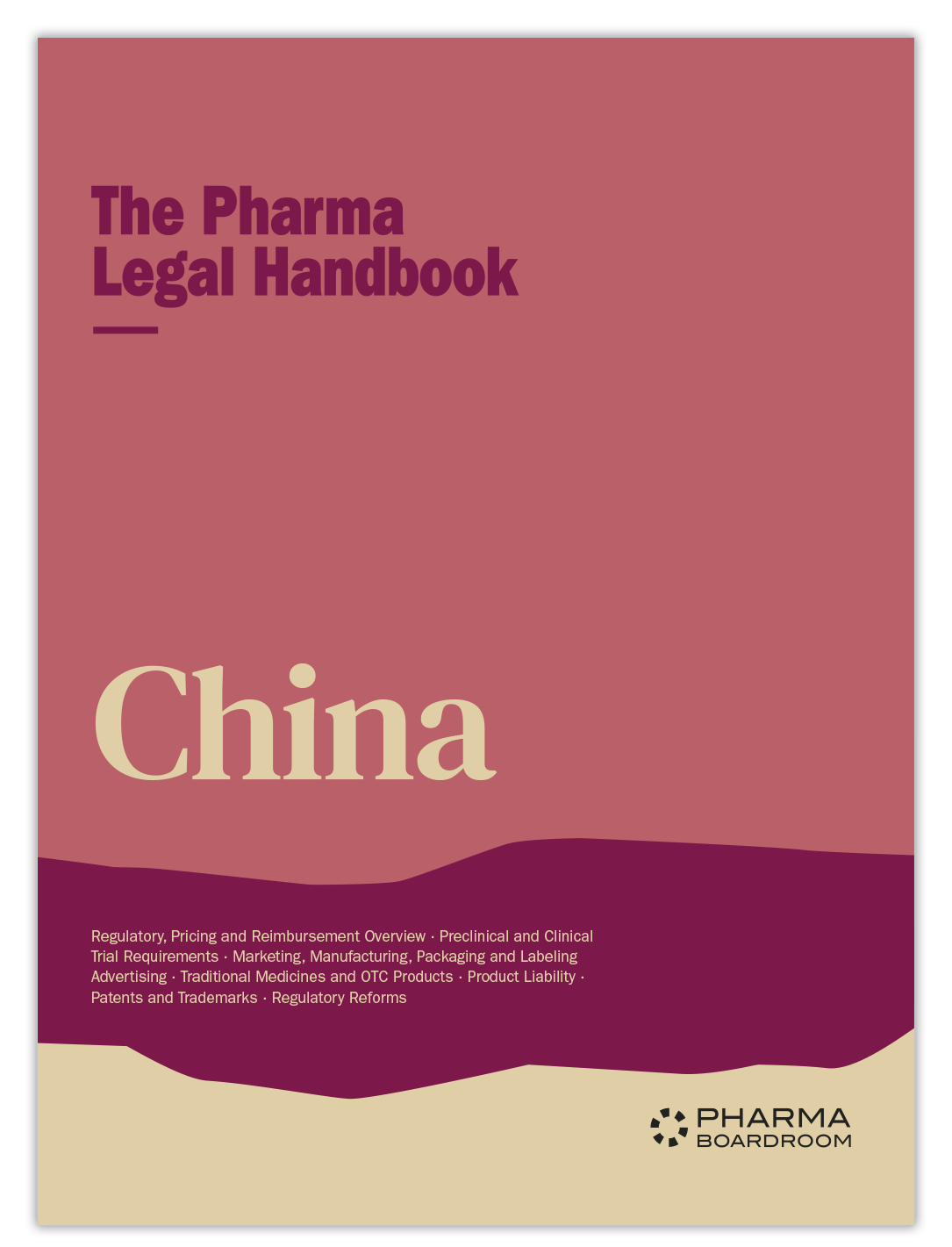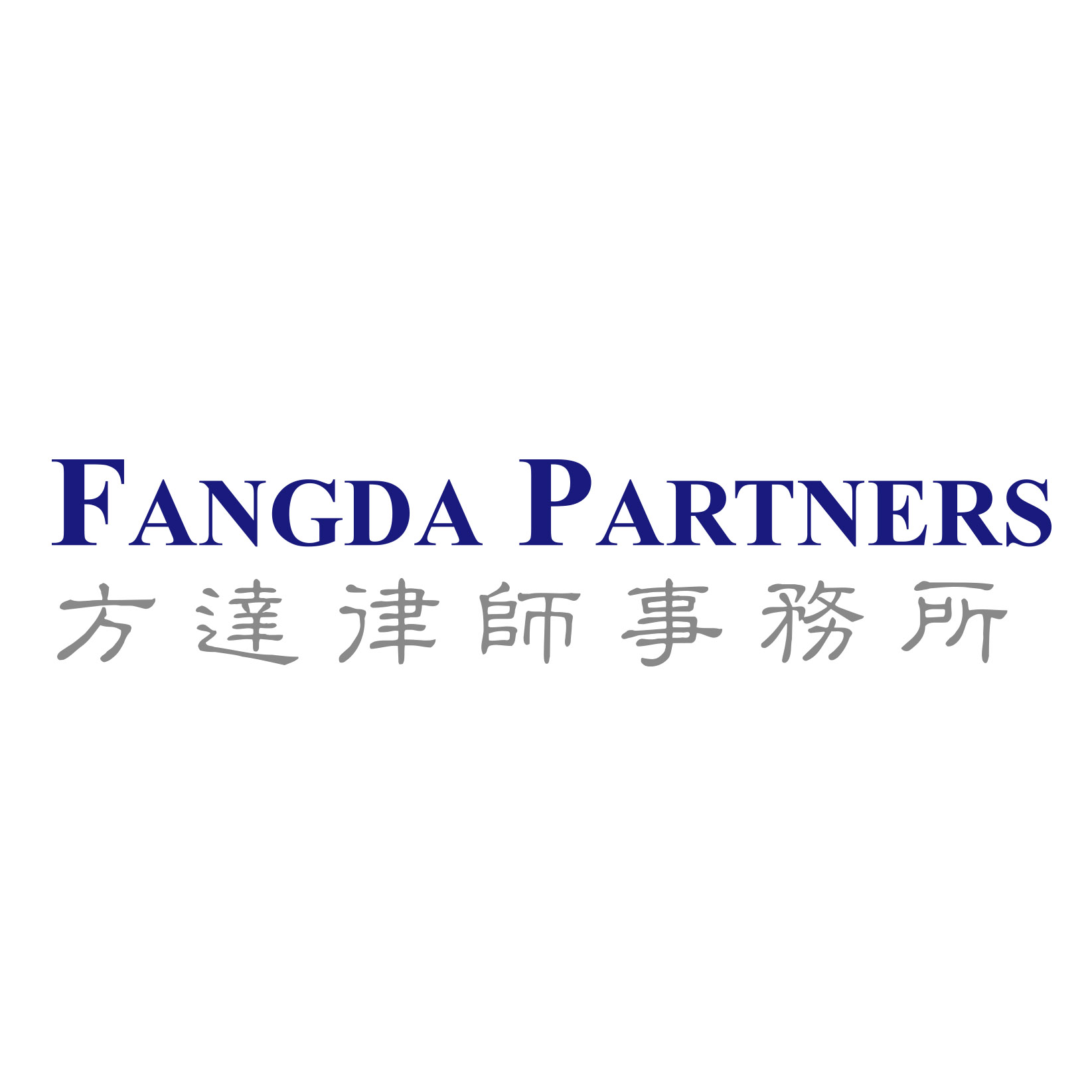The Pharma Legal Handbook: China
 The Pharma Legal Handbook: China answers essential questions about the legal and regulatory environment for pharmaceuticals in China. It is a must-have for any company operating in the country or looking to enter the market.
The Pharma Legal Handbook: China answers essential questions about the legal and regulatory environment for pharmaceuticals in China. It is a must-have for any company operating in the country or looking to enter the market.
Prepared in association with Fangda Partners, a leading Chinese law firm, it should answer any questions linked to regulation, pricing, clinical and preclinical trials, marketing, manufacturing, trademarks and patents.
If legal handbook content is updated, you will receive a free updated PDF for up to one year after purchase.
January 2019
1. Biosimilars & Biologics: China
Key legal info on biosimilars & biologics in China. Prepared in association with Fangda Partners, one of China’s most prestigious and well-regarded law firms. This is an extract from The Pharma Legal Handbook: China, which can be purchased here for GBP 119.
1. Are biosimilar medicines considered the same as generic medicines in your country?
The basic principles of research and evaluation of biosimilar medicines are similar to that of generic medicines, but the regulation in practice is different. Biosimilar medicines are included in the category of biologics for the purpose of regulation.
2. Are all biologic medicines, including biosimilar medicines patentable in your country?
There is no specific legal restriction on the patentability of biologic medicines. As long as biologic medicines meet the requirements for a patent, they can be registered.
3. Is there a specific regulatory framework for the marketing authorization of biosimilar medicines in your country? If yes, what is the regulatory framework for the authorization of biosimilar medicines?
The NMPA promulgated the Technical Guidelines for Research and Development and Evaluation of Biosimilars in 2015. Generally, there is no specific regulatory framework for the marketing authorization of biosimilar medicines in China.
4. What kind of data package is needed to obtain approval for a biosimilar drug? Is this any different to the requirements for the original Biologics drug?
The research and development of a biosimilar drug is based on the similarity study between the biosimilar and original biologics drug, which supports the safety, effectiveness and quality control of the biosimilar drug.
In addition, in practice, the Centre for Drug Evaluation (hereinafter referred to as the “CDE”) of the NMPA suggests the sponsor collect the immunogenicity data of all subjects in all clinical studies (including human PK or PD studies). Reasonable sampling time and the follow-up period should be set according to the immunogenicity characteristics of different products. The duration of any treatment course, pharmacokinetic characteristics of preparations and the occurrence time of the humoral immune response should be taken into account. The CDE suggests the sponsor may discuss with CDE case by case. Attention should also be paid to any difference of immune response between biosimilar and the original biologics drug, and the causes of the difference and their impact on the effectiveness and safety should be analysed.
5. What are the requirements for the choice of the reference comparator product?
Please refer to Question 6.
6. Can the comparator product be sourced from another regulatory jurisdiction? If yes, what are the data needed to support this approach?
According to an academic paper written by a team of the CDE, the reference comparator product should be the original biologics drug which has obtained the PRC marketing authorization, and products from the same origin should try be used as the reference comparator product in each stage of research and development. For those that cannot be obtained in China through commercial channels, other appropriate channels can be considered, but bridging comparative studies of the reference comparator product from different sources are required, or comparable evidence between reference comparator products from different sources should be provided.
In addition, the original biologics drug which has been approved for import registration or clinical trials in China should be selected as the reference comparator product for clinical trials of biosimilars. Only after the consent of the CDE, can the original biologics drug from the place of origin which has not been approved be used for clinical trials. The reference comparator product selected for the comparative study of similarity in each stage of research and development should be the product from the same origin.
7. How are the prices of biosimilar medicines regulated? Is this any different to the requirements for the original Biologics drug?
There is no regulation on the pricing of biosimilar medicines in China and there is no difference from the requirements for the original biologics drug.
8. What is the reimbursement policy for biosimilar medicine? Is this any different to the requirements for the original Biologics drug?
Once the biosimilar medicines are included in Drug Catalogue (as defined in Question 7, Chapter: Orphan Drugs and Rare Diseases), the prices of biosimilar medicines can be reimbursed (mostly) and covered by national medical insurance.
This is not different from the requirements for the original Biologics drug.
9. Does biosimilar competition impact the reimbursement policy of the originator reference products?
No impact.
10. What is the legal framework for biosimilar medicines prescribing (clinical decision maker) and dispensing (pharmacy level, hospital or retail)? Is this any different to the requirements for the original Biologics drug?
There is no legal framework for prescribing and dispensing biosimilar medicines.
11. Is the system considering physician-led switching and/or pharmacy-level substitution (without involvement of the clinical decision maker)?
Physician-led switching applies.
12. What are the post – authorisation requirements (including pharmacovigilance, risk management plans, post-approval studies) for biosimilar medicines? Is this any different to the requirements for the original Biologics drug?
Currently, there are no such specific requirements for biosimilar medicines.
13. Are there specific policies and requirements in terms of biosimilar medicines labelling in the event of second medical use patents? Is this any different to the requirements for the original Biologics drug?
According to the academic paper written by a team of the CDE, the labelling of biosimilar medicines should not affect the clinical use and should be conducive to the safety monitoring after marketing.
In practice, at present, it is advisable to add such description in the header of the first page of the package insert as “The biosimilar medicine (XXX) refers to the biosimilar drug of the reference comparator product (XXX)”; to add the definition of “biosimilar medicine” at the bottom of the first page: “Biosimilar medicine means the data supporting the marketing authorization of this biological product has proved that this biological product is highly similar to the reference comparator product approved by the NMPA, and there is no difference in clinical significance. This package insert is consistent with that of the original biologic drug.”
The clinical trial data in the package insert of biosimilar medicines should reflect the effectiveness and safety, not the similarity. As to the use of names of biosimilar medicines in the package insert, it is necessary to differentiate from the name of reference comparator product, the name of similar drug and the generic name. When quoting the clinical research data of reference comparator product, it is advisable to use the generic name of the reference comparator product instead of the brand name.
14. Have there been any significant legal/judicial developments in relation to biosimilars in your country? (Including but not limited to IP, procurement, competition, misleading information campaign, access to reference comparator product)
The significant legal development is that in order to improve the accessibility of biosimilars to meet the needs of patents, more and more regulations and guidelines on research and development of biosimilars have been promulgated.
15. Are there proposals for reform or significant change to the legal, regulatory, procurement of biosimilars? If yes, when are they likely to come into force?
The draft of the Technical Guidelines for Similarity Evaluation and Indication Extrapolation of Biosimilar Drugs (生物类似药相似性评价和适应症外推技术指导原则) has been issued for comments. After the comment stage ends, the Guidelines are likely to be promulgated and come into force soon.
Also from this Legal Handbook
2. Localization: China
Want to know more about localization in China? Prepared in association with Fangda Partners, one of China’s most prestigious and well-regarded law firms. This is an extract from The Pharma Legal Handbook: China, which can be purchased here for GBP 119.
1. Are there any rules or regulations requiring and/or encouraging localization in your country? What is the legal framework defining these localization rules and policies?
Yes. The key regulations are the Pharmaceutical Administration Law (药品管理法) and the Regulations for the Implementation of the Drug Administration Law (药品管理法实施条例). There are several announcements or decisions regarding the tariffs and authorization of imported drugs such as the Decision of the NMPA on Matters concerning the Adjustment of the Registration Administration of Imported Drugs (国家食品药品监督管理总局关于调整进口药品注册管理有关事项的决定) (hereinafter referred to as the “Decision”) and the Announcement of the Customs Tariff Commission of the State Council on Reducing the Import Tariffs on Drugs (国务院关税税则委员会关于降低药品进口关税的公告) (hereinafter referred to as the “Tariff Announcement”).
2. Have there been any recent significant changes involving localization rules? If yes, when did they take place and what did they involve?
The NMPA has taken an open attitude towards localization and is encouraging the importation of drugs by simplifying clinical trial requirements and lowering tariffs.
3. Is the process of obtaining a marketing authorization impacted by localization policies in your country? If yes, how so (what are the incentives received or the requirements)?
Yes. According to the Decision, there are following simplified requirements:
- with respect to a foreign new chemical drug or a foreign innovative biological drug for therapeutic use on which an application for the clinical trial or an application for the market authorization has been filed, the requirements for obtaining the market authorization of the country or region of production at the place where the overseas pharmaceutical production business is located shall be cancelled.
- where a registration application has been accepted before the issuance of this Decision and the clinical trial requirement of imported drugs is exempted based on the international multi-centre clinical trial data, if the requirements of the Measures for the Administration Measures for Drug Registration (药品注册管理办法) and relevant regulations are complied with, the import of the drugs may be directly approved.
4. Is the pricing process for pharmaceutical products impacted by localization policies in your country? If yes, how so (what are the incentives received or the requirements)?
N/A
5. Is the reimbursement of pharmaceutical products impacted by localization policies in your country? If yes, how so (what are the incentives received or the requirements)?
Yes. In recent years, more and more imported drugs have been included in the Drug Catalogue (defined in Question 7 of Chapter: Orphan Drugs and Rare Diseases).
6. Is the access to public or public tenders of pharmaceutical products impacted by localization policies in your country? If yes, how so (what are the incentives received or the requirements)?
Yes, given that more imported drugs have been included in the Drug Catalogue, more citizens can afford imported drugs.
7. Are import tariffs, importation and/or exportation permits, trade and/or taxation of pharmaceutical products impacted by localization policies in your country ? If yes, how so?
Yes. For the purposes of reducing the burden of drug expenses on patients, especially cancer patients, and offering them more medication options, since May 1, 2018, the import tariffs on all common medications including anti-cancer drugs, alkaloid drugs with anti-cancer effects, and imported traditional Chinese medicines shall be cancelled, according to the Tariff Announcement.
8. Are there any other incentives or advantages offered by the current local localization rules in your country? If yes, what are they?
N/A
9. Are there discussions about the possibility of implementing localization policies in your country? If yes, what are the proposed reforms and when should they come into place?
N/A
Also from this Legal Handbook
3. Orphan Drugs & Rare Diseases: China
An intro to the legal situation for orphan drugs and rare diseases in China. Prepared in association with Fangda Partners, one of China’s most prestigious and well-regarded law firms. This is an extract from The Pharma Legal Handbook: China, which can be purchased here for GBP 119.
1. What is the definition of Rare Diseases in your country?
As of now, there is no definition of Rare Diseases in China. The List of Rare Diseases (罕见病目录) promulgated by the National Health Commission, the Ministry of Science and Technology, the Ministry of Industry and Information Technology, the NMPA and the Bureau of Traditional Chinese Medicine in 2018, and the Guidelines for Diagnosis and Treatment of Rare Diseases (2019 version) (罕见病诊疗指南(2019年版)) promulgated by the National Health Commission set out various rare diseases. But the two documents aforementioned are both for reference only, and have no legal binding effect.
2. Does the designation of ‘Orphan Drug’ exist in your country? (Does it correspond with the definition of Rare Diseases?)
The designation of “Orphan Drug” does not exist in China. In practice, it is generally believed that Orphan Drug means Drug for Rare Diseases.
3. What is the regulatory framework for the authorization of an Orphan Drug? (Is this regulatory framework based on Rare Disease status or can it alternatively be based on Orphan Drug foreign status?)
The fundamental legislation for the authorization of Orphan Drugs is the Administration Measures for Drug Registration (药品注册管理办法) and some implementing rules, such as the Announcement on Optimizing the Review and Approval of Drug Registration (关于优化药品注册审评审批有关事宜的公告) (hereinafter referred to as the “Announcement”) promulgated by the National Health Commission and the NMPA in 2018.
This regulatory framework is neither based on the Rare Disease status nor alternatively based on Orphan Drug foreign status. In general, all new drugs must go through four steps before being marketed: pre-clinical research, application for clinical trial, clinical trial and approval for drug registration and production.
4. Does your country have pro- visions for relaxed clinical trial/ scientific evidence requirements in respect of Orphan Drugs as compared to other drugs?
Yes. In the Announcement, it is provided that if the marketing authorization applicant of an imported drug considers that there is no ethnic difference as to the effectiveness of Orphan Drugs with foreign marketing authorization, such applicant can directly submit the clinical trial data obtained from abroad when applying for the PRC marketing authorization.
5. Is there an expedited pathway for Orphan Drugs?
Yes. When applying for PRC marketing authorization for an Orphan Drug, the applicant may apply for preferential evaluation and approval procedure: the time limit for evaluation of clinically urgently needed Orphan Drugs that have been marketed abroad but have not been marketed domestically is 70 days, much shorter than the 200-day time period required for general marketing authorization application.
6. Are foreign marketing authorizations recognized in your jurisdiction for Orphan Drugs? If yes, marketing authorizations from which countries are recognized?
Foreign marketing authorizations for Orphan Drugs are not recognized in China. But the applicant of an Orphan Drug with foreign marketing authorization can be entitled to the expedited application for PRC marketing authorization as described in Question 5 of this Exhibit.
7. Can Orphan Drugs be reimbursed? If so, is there a specific reimbursement procedure for Orphan Drugs?
Some Orphan Drugs listed in the Drug Catalogue of National Basic Medical Insurance, Industrial Injury insurance and Maternity Insurance (国家基本医疗保险、工伤保险和生育保险药品目录) (hereinafter referred to as the “Drug Catalogue”) by the National Medical Insurance Bureau, Ministry of Human resources and Social Security can mostly be reimbursed and covered by national medical insurance. There are no specific reimbursement procedures for Orphan Drugs.
8. How are the prices of Orphan Drugs regulated?
There is no regulation of the pricing of Orphan Drugs in China. Nonetheless, to enable more and more people with rare diseases to be able to have access to Orphan Drugs, the National Medical Insurance Bureau endeavours to negotiate and enter into agreement with PRC marketing authorization holders of the Orphan Drugs to help lower the price and to have the Orphan Drugs included in the Drug Catalogue. After the Orphan Drugs have been included in the Drug Catalogue, the prices of Orphan Drugs can be reimbursed (mostly) and covered by national medical insurance.
Although the inclusion in the Drug Catalogue will help to lower prices of Orphan Drugs, that also offers the opportunity for pharmaceutical companies to generate extra sales. That is the reason why some Orphan Drug pharmaceutical companies agree to include their Orphan Drug in the Drug Catalogue.
9. In case of reference price based on a basket of countries, what countries are included?
N/A.
10. Have there been any significant legal/judicial developments in relation to Orphan Drugs in your country?
We have seen more and more Orphan Drugs being included in the Drug Catalogue, making originally expensive drugs affordable to thousands of families. In addition, the expedited application for marketing authorization of foreign Orphan Drugs is now well established, which may lead to the marketing of more Orphan Drugs in China.
11. Are there proposals for reform or significant change to the regulation of Orphan Drugs? If yes, when are they likely to come into force?
In China, there is a proposal to pass an Orphan Drug Act similar to that of USA to incentivize pharmaceutical companies to develop Orphan Drugs. There is no specific timeline for the formulating and promulgation of PRC Orphan Drug Act.
Also from this Legal Handbook
4. Cannabinoid Drugs, Medicinal Cannabis & Opioid Drugs: China
Cannabinoid drugs, medicinal cannabis & opioid drugs in India – a comprehensive legal overview. Prepared in association with Fangda Partners, one of China’s most prestigious and well-regarded law firms. This is an extract from The Pharma Legal Handbook: China, which can be purchased here for GBP 119.
CANNABINOID DRUGS
1. Are Cannabinoid Drugs authorized in your country?
Cannabinoid Drugs are not authorized in China.
2. What are the regulatory authorities with jurisdiction over Cannabinoid Drugs?
N/A
3. Is there a specific regulatory framework for the authorization, pricing, and reimbursement of Cannabinoid Drugs?
N/A
4. Which are the cannabinoid drugs that have received market approval to date?
N/A
5. Who can prescribe Cannabinoid Drugs?
N/A
6. Is there a list of doctors authorized to prescribe Cannabinoid Drugs?
N/A
7. What approvals or notifications are required to prescribe Cannabinoid Drugs?
N/A
8. Which organizations are authorized to sell/distribute Cannabinoid Drugs available?
N/A
9. Is there a list of retailers/ distributors authorized to sell Cannabinoid Drugs?
N/A
10. Are there proposals for reform or significant change to the regulation of Cannabinoid Drugs?
N/A
11. When are they likely to come into force?
N/A
MEDICINAL CANNABIS
12. Is Medicinal Cannabis authorized in the country?
Medicinal Cannabis is not authorized in China.
13. What are the regulatory authorities with jurisdiction over Medicinal Cannabis?
N/A
14. What is the regulatory framework for the authorization, pricing, and reimbursement of Medicinal Cannabis?
N/A
15. How is the production and import of Medicinal Cannabis regulated and by which agencies/authorities?
N/A
16. What approval or notifications are necessary to produce or import Medicinal Cannabis?
N/A
17. What is the regulatory framework for the marketing and distribution of Medicinal Cannabis?
N/A
18. How can patients obtain Medicinal Cannabis?
N/A
19. Who can prescribe Medicinal Cannabis?
N/A
20. Is there a list of doctors authorized to prescribe Medicinal Cannabis?
N/A
21. What approvals or notifications are required to prescribe Medicinal Cannabis?
N/A
22. Where is Medicinal Cannabis available?
N/A
23. Is there a list of retailers authorized to sell Medicinal Cannabis?
N/A
24. Are there proposals for reform or significant change to the regulation of Medicinal Cannabis?
N/A
OPIOID DRUGS
25. Are Opioid Drugs authorized in your country?
Yes, quite a few Opioid Drugs have been authorized in China, such as Morphine, Remifentanil, Buprenorphine.
26. What are the regulatory authorities with jurisdiction over Opioid Drugs?
National Medical Products Administration (hereinafter referred to as “NMPA”).
27. Is there a specific regulatory framework for the authorization, pricing, and reimbursement of Opioid Drugs?
Currently, there is no specific regulatory framework for the authorization, pricing, and reimbursement of Opioid Drugs. But there is a special regulation named Regulation on the Administration of Narcotic Drugs and Psychotropic Drugs (麻醉药品和精神药品管理条例) promulgated in 2005, later modified in 2013 and 2016, which regulates the planting, clinical study, business, use, storage, and transportation of narcotic drugs (including Opioid Drugs) and psychotropic drugs.
28. Which are the Opioid drugs that have received market approval to date?
Quite a few Opioid Drugs have been authorized in China, such as morphine, Remifentanil, Buprenorphine.
29. Who can prescribe Opioid Drugs?
Practicing physicians.
30. Is there a list of doctors authorized to prescribe Opioid Drugs?
N/A
31. What approvals or notifications are required to prescribe Opioid Drugs?
The physicians are required to obtain the qualification for prescribing narcotic drugs and the psychotropic drugs of category I in order to prescribe Opioid Drugs.
32. Which organizations are authorized to sell/distribute Opioid Drugs available?
Only drug distribution companies with the specific approval for the distribution of narcotic drugs (including Opioid Drugs) and psychotropic drugs are authorized to distribute Opioid Drugs to medical institutions such as hospitals and clinics. No Opioid Drugs can be sold through retail.
33. Is there a list of retailers/ distributors authorized to sell Opioid Drugs?
N/A
34. Are there proposals for reform or significant change to the regulation of Opioid Drugs?
N/A
35. When are they likely to come into force?
N/A
Also from this Legal Handbook
5. Regulatory Reforms: China
The key facts about regulatory reforms in Chinese pharma. Prepared in association with Fangda Partners, one of China’s most prestigious and well-regarded law firms. This is an extract from The Pharma Legal Handbook: China, which can be purchased here for GBP 119.
1. Are there proposals for reform or significant change to the healthcare system?
Reform of Medical Insurance Payments
To improve the cost-effectiveness of the current healthcare system, pilot policies of Diagnosis-Related Groups (“DRG”) payments have been implemented in 30 cities across the nation. All of them have passed the pre-assessment and entered the trial implementation phase. Pilot policies of Big Data Diagnosis-Intervention Packet (“DIP”) payments are to be implemented in 71 cities.
The DRG payment system is a payment management model under which patients will be assigned to different groups based on their disease diagnosis, and medical reimbursement will be calculated and paid according to the group standard.
The DIP payment system is a payment management model using big data to fine-tune the categorization of diagnosis and treatment pathways already established in the DRG system.
“One-Invoice” Policy
The “one-invoice” policy in the drug distribution has taken place on a trial and non-compulsory basis in a few regions in China. While the “two-invoice” policy which was initially launched nationwide in 2016 requires that the issuing of the drug manufacturer’s invoice to the distributor be directly followed by the distributor’s invoice to the end customer (i.e. the public hospitals), the “one-invoice” policy takes a step further by encouraging the drug manufacturer directly issue invoice to the end customer, aiming to increase the transparency in drug prices and eliminate excessive profit margins associated with multi-tiered distribution models.
To name a few local practices of the “one-invoice” policy:
- The government of Gaotai county, Gansu province issued the “Key Points of Implementation of Health Insurance Policies in 2021”, pointing out that it is necessary to continue improving the system of bidding and procurement of drugs and medical consumables, optimize the classification of drugs and medical consumables in procurement activities, gradually liberalize the delivery market, incentivize and support direct delivery by manufacturers or third parties designated by manufacturers, and promote delivery under the “one-invoice” policy, in order to reduce the prices of drugs and provide high-value medical products.
- The health committee of Pingdingshan, Henan province, issued the Notice on Further Strengthening the Management of the Distribution of Drugs and Consumables in Public Medical Institutions, stating that public medical institutions shall play a primary role in the market of drugs (or consumables) procurement and, subject to the principles of openness, fairness and impartiality, select those suppliers which can carry out the “one-invoice” policy and supply drugs and consumables directly to medical institutions in the city.
- The authority of Anhui province has also released a commentary, stating that reform is a process of breaking the inherent profit distribution pattern, mirroring the changes to drugs and consumables procurement. In terms of securing product supply, the authority has indicated that prices are reduced as far as possible but without compromising the quality. The winning bidder of any drug procurement contact must have the prime responsibility for quality and supply. Anyone in this market must move towards issuing one, rather than two, invoices, with the aim of reducing the costs of distribution. The winning bidder will either deliver the procured products or engage a third party with the required capability and good credit.
- The health insurance bureau of Quanzhou, Fujian province, is encouraging the use of one invoice when it comes to high-value medical consumables as well as ensuring better record keeping, stamping out dishonesty and taking greater control of contract performance. The bureau is also working towards synchronizing healthcare, healthcare insurance with the goal of optimizing the prices of medical services and putting in place measures that support the delivery of healthcare.
2. When are they likely to come into force?
Some of the reforms proposed by the Innovation Opinion have already come into force, for example:
- The establishment of a filing system for the clinical trial site (previously, all sites must go through a stringent approval process to host clinical trials).
- The establishment of a filing system for clinical trial application replacing the previous approval system. NMPA has 60 business days to conduct its review for new drug clinical trial applications, and then the application will be deemed approved if no objection or question is raised.
- Clinical data generated in foreign trials can be used to support a marketing authorization application in China.
Some of the proposed reforms are still pending and will be enforced when related implementing rules are promulgated, including the patent linkage and regulatory data protection system and the expansion of the MAH system.




